Kennebec County, Maine
Sphingidae
Lapara bombycoides, Sidney, Kennebec County, Maine,
July 2011, courtesy of Steven Lemieux, via Daniel Marlos
|
|
Updated as per James P. Tuttle's The Hawk Moths of North America, July 2010 Updated as per Butterflies and Moths of North America website (formerly USGS), July 2010 Updated as per personal communication with Steven Lemieux, via Daniel Marlos (WTB); C. undulosa; L. bombycoides; H. thysbe; July-August 2011 Updated as per personal communication with Leslie Hubbard (Pachysphinx modesta, Litchfield, June 5, 2015); June 6, 2015 |
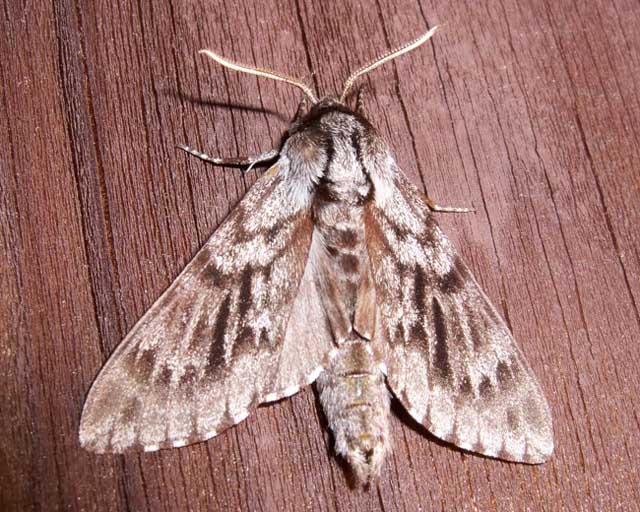
Lapara bombycoides, Sidney, Kennebec County, Maine,
July 2011, courtesy of Steven Lemieux, via Daniel Marlos
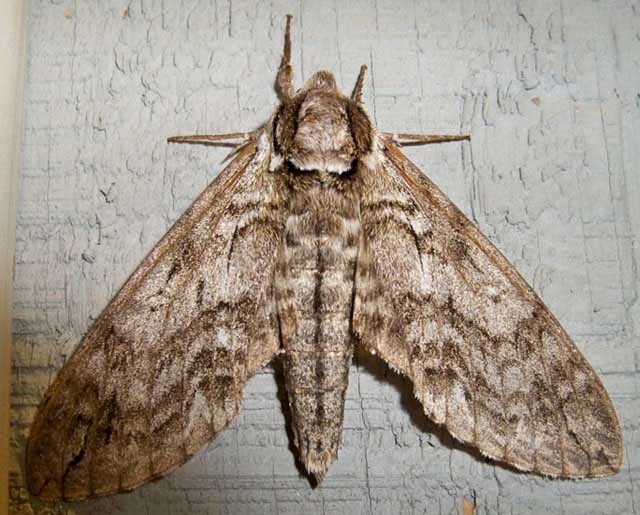
Ceratomia undulosa, Sidney, Kennebec County, Maine,
July 2011, courtesy of Steven Lemieux, via Daniel Marlos
Thirty-seven Sphingidae species are listed for Maine on the U.S.G.S. website. Not all of the species are reported or anticipated in Kennebec (seven are reported on U.S.G.S. as of July 13, 2010). It is hoped that this checklist, with the thumbnails and notes, will help you quickly identify the moths you are likely to encounter.
A "WO" after the species name indicates that I have no confirmed reports of this species in your county, but I (William Oehlke) expect that this moth is present. A "USGS" indicates the moth is reported in Lepidoptera of North America, #1. Distribution of Silkmoths (Saturniidae) and Hawkmoths (Sphingidae) of Eastern North America, an excellent little booklet available through Paul Opler.
Please help me develop this list with improved, documented accuracy by sending sightings (species, date, location), preferably with an electronic image, via email to Bill Oehlke.
Please also send your sightings to BAMONA, an excellent online resource.
Many thanks to Leslie Hubbard who encountered a freshly emerged female Pachysphinx modesta, June 5, 2015. Leslie got to watch the moth inflate its wings, and then found it coupled with a male the following morning.
Leslie writes, "Was cleaning out my flower bed today June 5, 2015 about 4:00 pm. All of a sudden "this thing" appeared - it was unlike anything I had seen before. Reminded me of a hellbender you see in streams. Within 4 hours it morphed into a big poplar sphinx. I have watched monarchs go through their life cycles but this was a new one on me. Thought you might enjoy the pictures. Really didn't know much about moth life cycles until today - thanks for all your wonderful information!"
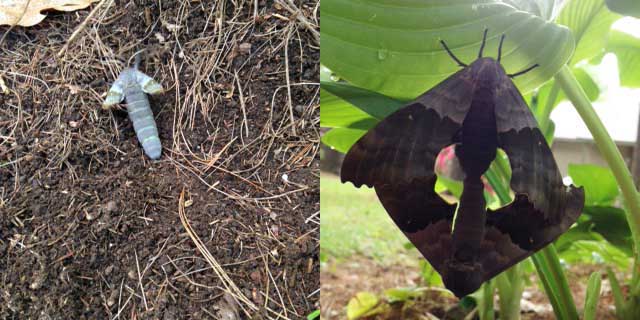
Pachysphinx modesta female newly emerged, left (June 5); in copula right (June 6),
Litchfield, Kennebec County, Maine, courtesy of Leslie Hubbard.
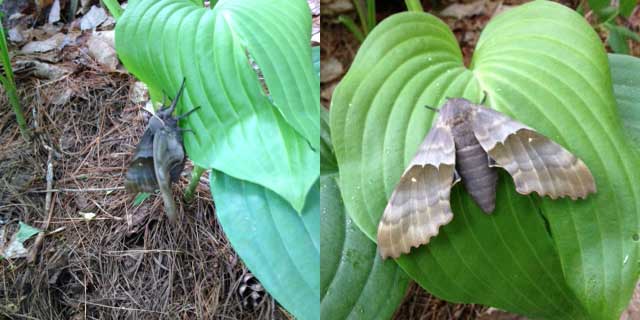
Pachysphinx modesta female hanging/inflating, left (June 5); inflated/resting (June 5),
Litchfield, Kennebec County, Maine, courtesy of Leslie Hubbard.
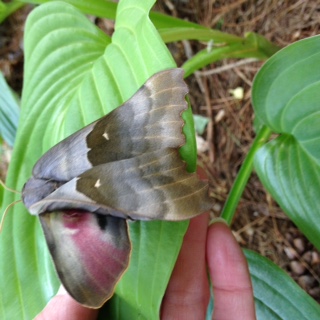 | Almost fully inflated, the wings are still quite soft. The inflating process usually takes 15-30 minutes, and then it is often an hour or two after that that fluid has hardened and wings are stiff and ready for flight.The female usually does not fly until she has copulated with a male. Shortly before midnight she extends a wick-like structure from abdominal tip and exudes a pheromone (scent) into the night sky. Males fly into the wind and track the pheromone to locate the female. |
Neither the male nor female will eat anything in the adult stage. They have no mouth parts or feeding tubes. It would seem their sole purpose is reproduction, and they only usually live off fats stored from their caterpillar days for an adult life of 5-8 days.
Perhaps in 4-6 weeks Leslie will find a caterpillar or two feeding on a nearby poplar or willow. There is probably one in her yard near the garden!
Visit Kennebec County Sphingidae Larvae.
Visit Maine Catocala: Underwing Moths.
Sphinginae subfamily
Smerinthini Tribe:
Macroglossinae subfamilyDilophonotini tribe:
See Hemaris comparison to help distinguish the next three species.
Philampelini tribe:
Macroglossini tribe:
|
Enjoy some of nature's wonderments, giant silk moth cocoons. These cocoons are for sale winter and fall. Beautiful Saturniidae moths will emerge the following spring and summer. Read Actias luna rearing article. Additional online help available.
Use your browser "Back" button to return to the previous page.
This page is brought to you by Bill Oehlke and the WLSS. Pages are on space rented from Bizland. If you would like to become a "Patron of the Sphingidae Site", contact Bill.
Please send sightings/images to Bill. I will do my best to respond to requests for identification help.
 Show appreciation for this site by clicking on flashing butterfly to the left. The link will take you to a page with links to many insect sites. |